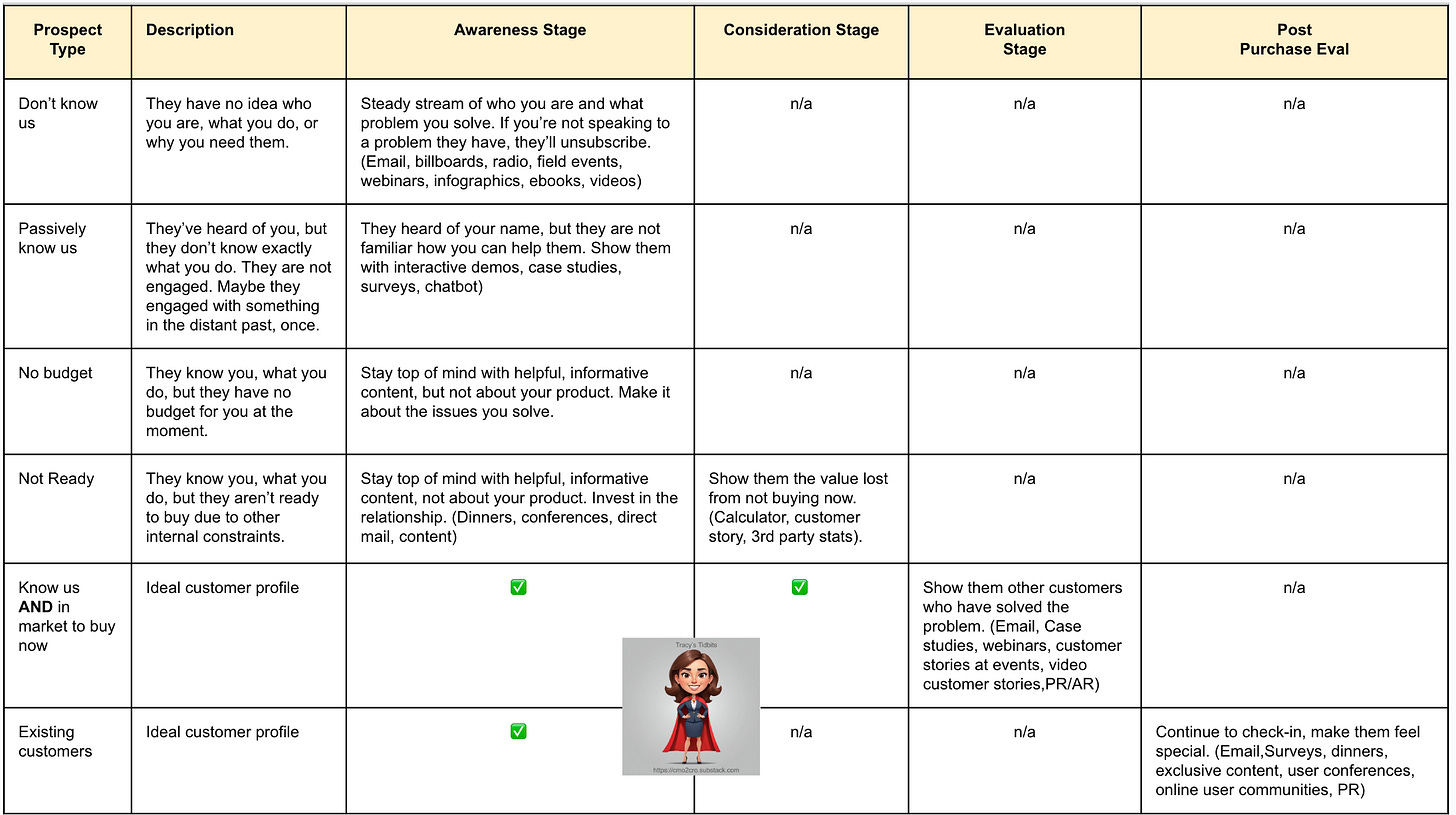Mapping out Your Buyer Journey vs Random Acts of Content Marketing
Often we come up with great campaign ideas, but they're not integrated and therefore become random acts of marketing.
I absolutely LOVE integrated campaigns. The idea of mapping out the buyer journey through an intimate series of messaging and activities to get someone to the buying or renewal stage is what sets apart great marketing.
Most campaigns start out as acquisition campaigns. Marketing is given some MQL/MQA number and they have to hit it because it’s the only way finance thinks you can measure success of all of the money marketing is spending.
But, you have multiple audiences you are reaching with your tactics given the size of your buying teams.
Your typical buyer audiences
(A) Those who don’t know you, never heard of your brand
(B) Those who have passively heard of you but you’re not really on their radar
(C) Those who know you and what your product does but:
aren’t ready to buy
or have no budget
(D) Those who know you and are in the market to buy your solution now
(E) Your existing customers
This is where the buyer journey map is super handy. Yes, it seems like a lot of nurture streams, but you’re just wasting your time if you’re treating everyone of these buyers the same because their needs are different and so should your tactics and messages be.
Buyer Journey Map
You’ll notice a few things here:
Most prospects in your database fall within the first 4 categories. They all need top of funnel content, yet different messaging. None of them need Consideration or Evaluation stage content because they’re not there yet. This is a common mistake made amongst Demand Gen who score people to MQL, which is why MQLs are a lagging indicator.
There are only 2 prospect types that really fall within your ICP. Those that know you and who are ready to buy now, and existing customers (land and expand/add-on). You don’t need to send them awareness content. They know who you are. You also don't need to send consideration content because you’ve already been “considered.” According to Wynter, 78% of B2B buyers shortlist only 3 vendors to get a demo with.
Your existing customers are always an afterthought until you need something. But your best bet is to invest in them early and frequently. Get that UGC (user generated content) by highlighting their success, inviting them to get on stage with you, asking for a quote from them for a press release, joining you on a webinar. That UGC will help you with your Awareness stage for your other 4 prospect types.
For other prospect journey map templates, Lucidchart offers one for free on their site.
Here’s how HubSpot thinks of it… (you can download all of their journey templates here)
Random acts of marketing
Often as marketers we do a lot of “things” and have trouble tying them together and then further mapping those things to the buyer’s journey. We’re all guilty of doing this at some point, but it needs to stop. It’s such a waste of time, energy, and resources.
Don’t be boring
If you sponsor an event, typically you send some emails to your prospects, try to book some meetings, come up with a theme, and maybe you might write an event recap. Zzzzzzzzzzzzzzz……….
But what if you sponsored an event, have a key message on your booth, an ebook to back up that key message, an infographic and blog to support the ebook, a customer story or quote to back up that message, and you do a post event webinar where you advertise in a post-event email drip to talk about that message? 💡
Most marketing campaigns are short lived. I try to make mine stretch 6-9 months mostly because people are dropping in and out of your funnel all of the time and they are moving in and out of prospect types constantly. (This is why some ebooks/webinars just keep on giving and giving for years).
Why your blog is probably a random act of marketing
While I love blogging, blogs unfortunately are another random act. If you went to all of the trouble to get them to your website, you better keep them there and convert them. The best way to keep them there is to interlink your content throughout. Your blogs should all have at least 1 to 2 internal links to other free ungated content. Believe me, if you’ve got a compelling enough story or content they will hand over their email address or ask for more information.
To gate or not gate?
I always hated this question because the truth is, most prospects are going to find the information from a peer or some other website, so just make it easy for them. Here’s the content that should be gated/ungated, IMHO:
Ungated
Blogs
Infographics
Webinar replays (see why below)
Videos
Customer stories/case studies
PR
ebooks
Checklists/listicles
Glossary of terms
Podcast
Gated
3rd party research data you paid real $ for
Self-hosted or co-hosted events
Webinar signups
Newsletter signups
But what about tracking and scoring?
You can score someone who views a piece of content (super easy to do in HubSpot, also relatively easy to do in Marketo), including a webinar replay. But again, I wouldn’t necessarily MQL someone who viewed a piece of content. These MQLs, while they help you reach your marketing goals, hardly convert to an SQL (usually less than 10% convert depending on your scoring methodology). It moves them down the funnel, but they’re still usually not ready to buy for one reason or another.






